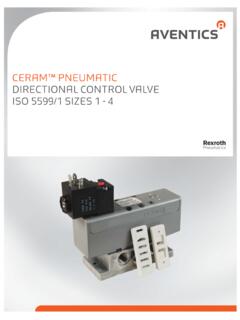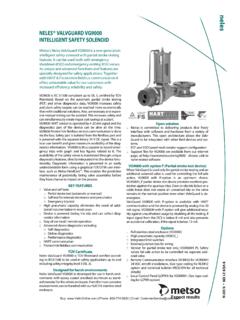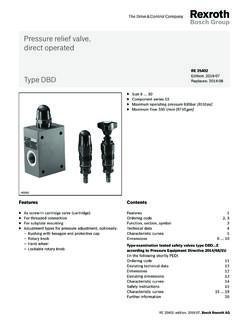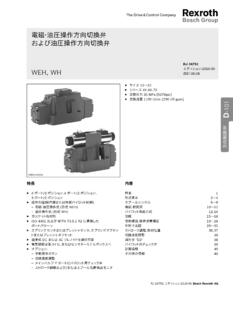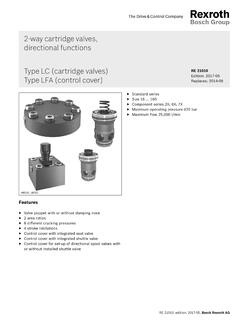Transcription of Ergonomics Guidebook for Manual Production Systems
1 Ergonomics Guidebook for Manual Production height 04 Work area 06 Reach zone 08 Parts presentation 09 Range of vision 10 Lighting 11 Equipment adjustments 12 Planning aids 14 The eight rules of Ergonomics for work systemsBenefit from Ergonomics Use the advantages of an ergonomically designed workstation system. We can support you with this and provide valuable suggestions. One example is this Ergonomics Guidebook , which contains the eight key rules of Ergonomics , covering the most essential aspects of EN ISO 6385. This Guidebook is a reference to help you methodically plan and implement ergonomic workstations and flow racks. Among other things, it takes employee size, tasks, and lighting into account. 304 Body height and working height 06 Work area08 Reach zone09 Parts presentation10 Range of vision11 Lighting12 Adjustment of work equipment14 Planning and design toolsErgonomics For motivated employees, higher productivity, and better quality An ergonomic workstation facilitates work and maintains good employee health.
2 The results: Increased motivation and satisfaction, higher performance, efficiency, and processing quality, as well as fewer absences due to illness. The bottom line: Ergonomics provide you with valuable benefits in the form of higher productivity, increased efficiency, and a decisive edge over the competition thus ensuring lasting success for your height and working heightManual workstations must accommodate a wide range of body heights to ensure that the largest percentage of the population is covered. Country-specific differences and regional requirements must also be taken into account. For example, in Germany, DIN 33 406 must be followed when specifying and designing a workstation. The most important factors for designing work equipment are the working height, proper sizing of the reach zones and required leg room, as well as definition of the appropriate range of vision.
3 All of these dimensions are derived from a standardized body of body heights The body heights of the population can be classified into four groups: fGroup 1: Smallest woman (only 5% are smaller) fGroup 2: Average woman and smallest man fGroup 3: Largest woman and average man fGroup 4: Largest man (only 5% are larger)Definition of the optimum working height The optimum working height is based on the body height range and the type of activity to be performed (see table). If you take all body heights into consideration, the average optimum working height for average requirements is 1125 mm for sit-down/stand-up optimum working height = 11251100120012501350 Work contentsHigh requirements forVisual inspection Fine motor skillsWorking heights in mmGroup 1 Group 2 Group 3 Group 4 Medium requirements forVisual inspection Fine motor skillsLow requirements forVisual inspectionHigh requirements forElbow-room100011001150125090010001050 1150 Group 1 Group 21650 mmGrouping of body heights in Germany: In accordance with DIN 33 402 and DIN EN ISO 7250 FrequencyGroup 31750 mmGroup 41855 mm Men:Women:1535 mm1625 mm1720 mm1125 mm 100 mmAverage optimum working height.
4 For all four population groupsGroup 41855 mmGroup 3 1740 mmGroup 2 1640 mmGroup 1 1535 mm 5400 mm600 750 mm1100 mm1400 mmBBACCR ecommended working heights: A: Higher container weight, B: Lower container weightC: Occasional handlingDefinition of the table height The table height follows from the optimum working height minus the height of the workpiece or insertion point. To ensure sufficient leg room for those in body height group 4 as well, we recommend a minimum height of 1000 mm for sit-down and stand-up workstations. Further criteria that must be taken into account: fFoot and leg room, depth and adjustment range of the footrest fSize and variation of workpiece dimensions fOccurring forces and weights fChanging types of equipment and insert heights fGreatly varying vision distances fLocal specifications (deviating body heights, legal requirements, etc.)
5 FAspects related to methods, safety, and efficiencyRexroth's sit-down/stand-up concept for Production The sit-down/stand-up concept developed and recommended by rexroth makes it possible to work at the same height when sitting and standing. This largely compensates for different body heights. The concept permits changes in posture, which reduces stress and increases performance. This is not possible with a purely sit-down or stand-up workstation rack design The container weight and type of activity are decisive when designing flow rack Systems . We recommend the arrangement shown in the figure. The following aspects should also be taken into account for material supply and removal: fTotal load on the employee during the shift fCountry-specific requirements and standardsRelevant parameters: For defining the table height for a sit-down/stand-up workstationTable heightWorking height H6 Work area fPromote dynamic activities: Static holding activity inhibits the blood circulation and supply of oxygen to the muscles.
6 This can lead to a drop in performance and processing quality. fAllow for varying physical exertion: For example, through sit-down/stand-up workstations or job rotation. Varying physical exertion reduces stress on the employee and increases performance. fMinimize exertion: For example, through the use of Manual roller sections or lifting aids, as well by selecting lighter weight the heart Work areas above the heart: Decreased blood circulation reduces performanceBelow the heart Work areas below the heart: A good supply of oxygen to the muscles and increased performanceThe required activities and work process are defined based on a specified cycle time. The optimum working method is determined in a method analysis that takes time, Ergonomics , and efficiency into account.
7 It s also important to consider any trends towards an aging work force or changing employee performance. According to our experience, inclusion of all concerned employees, for example from assembly, quality assurance, and logistics, ensures the best results and long-term acceptance of the method and, as a result, acceptance of the workstation system. The work area height should always be between 800 mm and 1500 mm. Here, the following rules must be observed: fAvoid work above the heart (over 1500 mm): Otherwise, the blood circulation and supply of oxygen to the muscles is reduced, which leads to a drop in performance. Work that requires bending (below 800 mm) taxes employees disproportionately and should be avoided. 7At restStatic activity Static activities, such as holding an object continuously, reduce the blood and oxygen supplyDynamic activity A sufficient oxygen supply is ensured with dynamic activitiesBlood requirementBlood supplyBlood requirementBlood supplyBlood requirementBlood supplyErgonomic workstations are at the center of assembly line Production Sit-down/stand-up workstations as well as material supply containers from rexroth provide an optimum basis for work without fatigue and can be adjusted to the needs of individual zoneThe following rules apply for an ergonomic reach zone design.
8 All containers, equipment, and operating elements must be easily accessible and arranged in the anatomic/physiological range of movement for the employee. Torso rotations and shoulder movements, particularly when under exertion (with weights 1 kg), should be avoided whenever of the three reach zones Area A fOptimum for working with both hands, as both hands can reach this zone and are in the employee's field of view fFor fine motor movements fPossible to handle lighter weights and also enables improved inspection and coordination activities fPure lower arm movements fSmaller muscle groups are in use fArea for workpiece support, workpiece pallet, or equipmentArea B fFor gross motor movements fArea for tools and parts that are often grabbed with one hand fUpper and lower arm movements without use of the shoulders and rotation of the torsoArea C fFor occasional handling.
9 Of empty containers or transferring parts to the range of movement for the next employee fWith shoulder and torso movementSit-down/stand-up workstation: Parts transfer via Eco-Flow roller sectionsReach zone for the smallest woman (body height group 1)All dimensions in mmYou can differentiate between three reach zones at the workstation: fArea A: Center of work, two-handed zone fArea B: Large reach zone fArea C: Extended one-hand zone 9 Parts presentationAll reach distances should be as short as possible to avoid unnecessary movements that add nothing to the value and thus avoid waste. Grab containers and parts containers that are in direct reach of the employee are ideal. The position of these containers should enable a flowing movement that curves upward away from the body when parts are following aspects must be taken into consideration for parts supply.
10 FPositioning of all grab containers in areas A and B fThe more frequently a grab container is used, the shorter the reach distance should be fHeavy parts should be stored within reach in the lower containers to avoid unnecessary exertion ( caused by lifting and lowering) fBending of the torso below 800 mm places a disproportionate strain on the human body fUse of geometric and physical features of the parts during parts transfer, through the use of a slide rail or roller conveyor fArrangement of different-sized containers according to parts geometry, maximum weight, and refill cycle fReduction of time for parts supply and removal by up to 68% (MTM Method of Time Measurement). Employees can concentrate on productive assembly work cL et our case lifters help you to keep sick days down fExchangeable material supply shuttles reduce setup times1045 30 60 Range of visionRange of vision from above: The field of view is red and the visual field is light of vision from the side: The field of view is red and the visual field is light optimal workstation design, it s important to follow recommendations on proper Ergonomics for vision as can differentiate between two vision areas: fIn the field of view (red vision area), several objects can be seen in focus simultaneously without moving the eyes or head.


